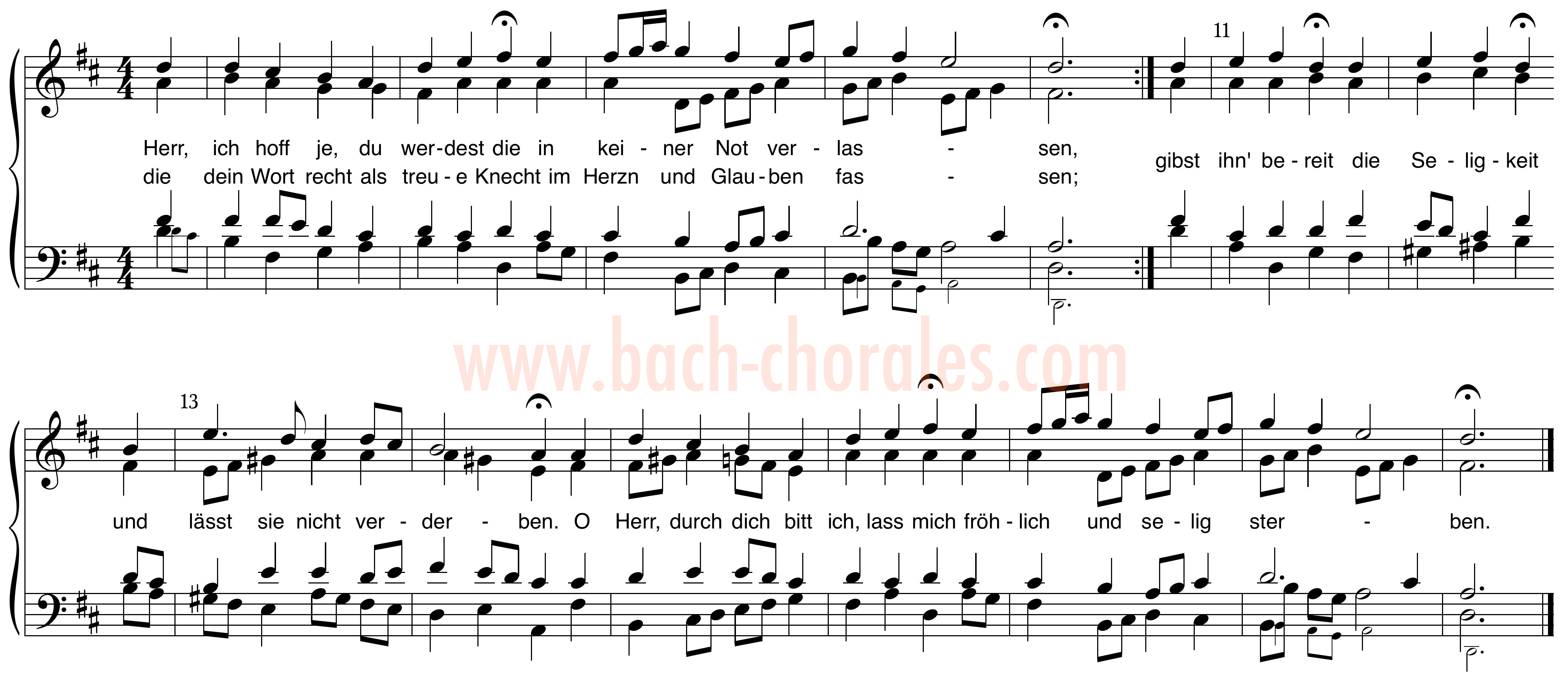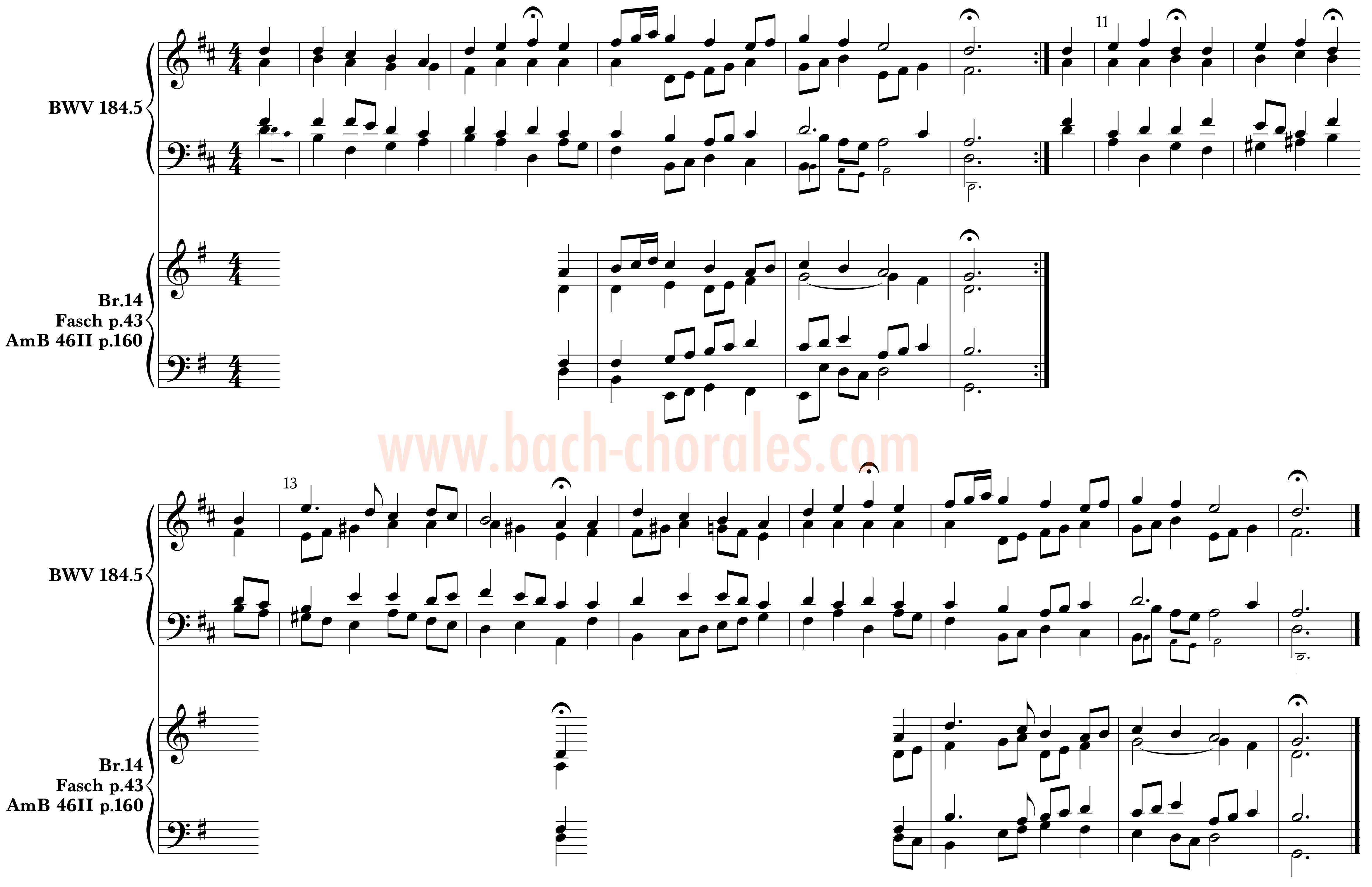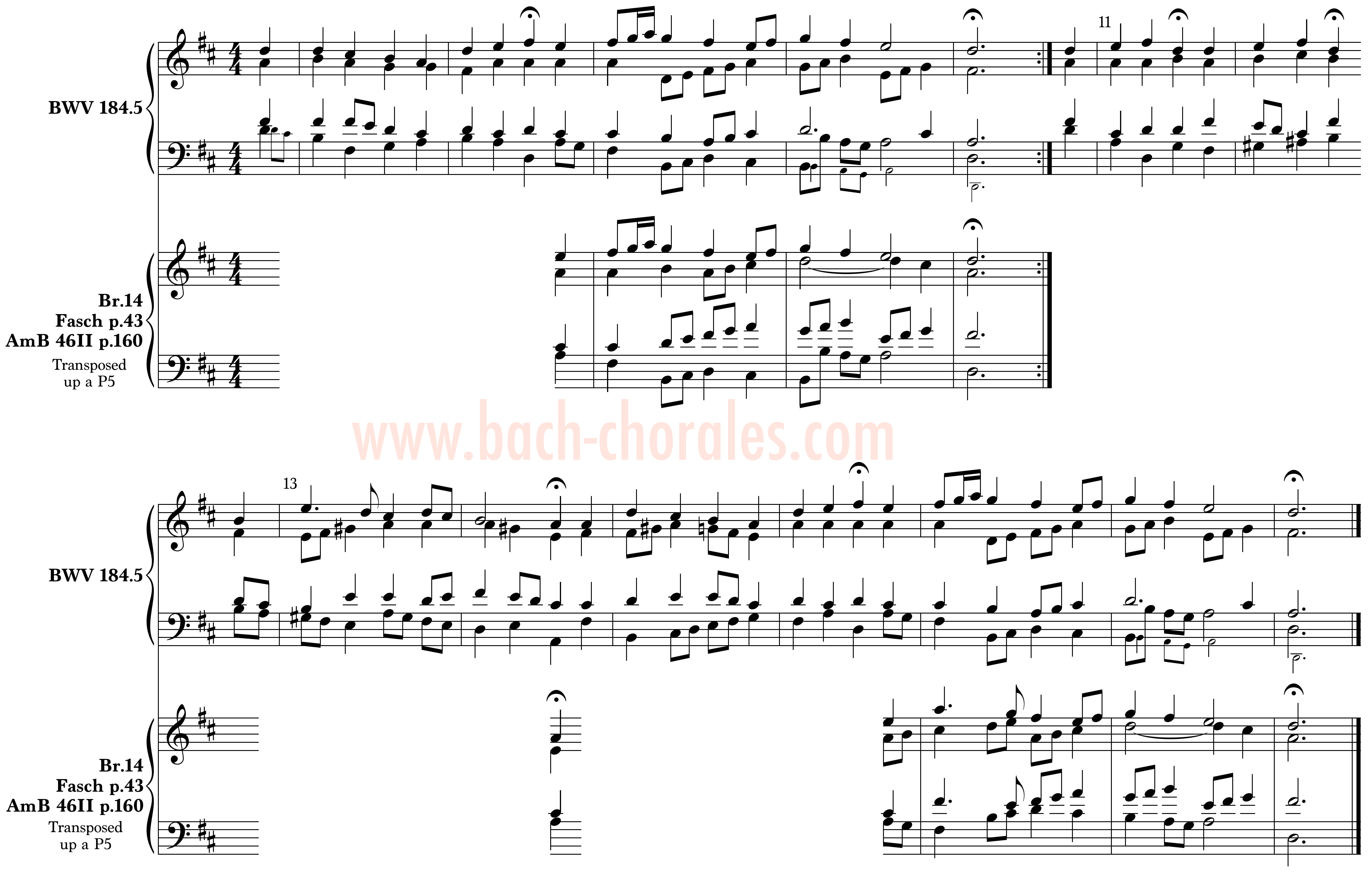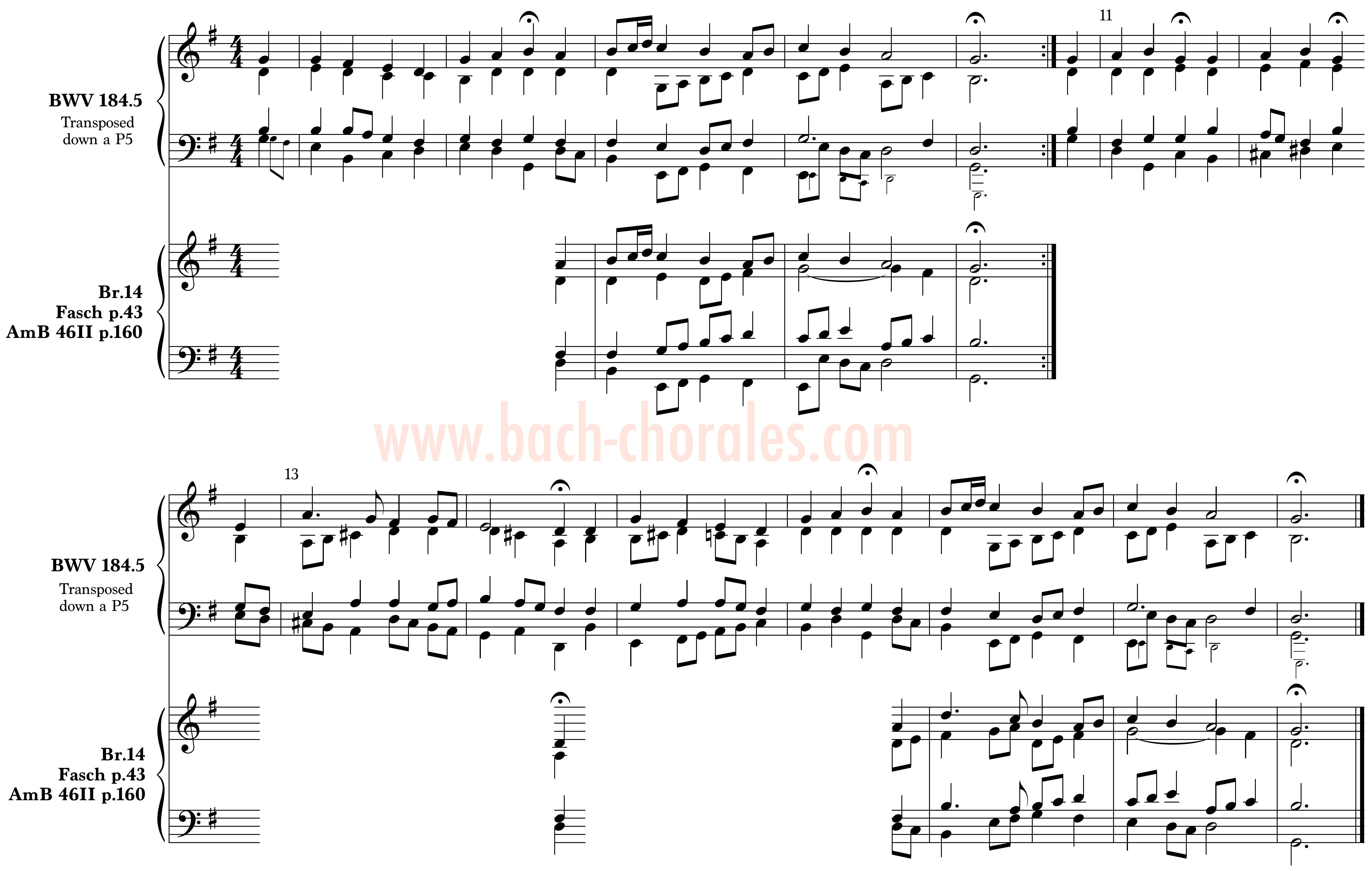 |





|
BWV 184.5

Previous: BWV 183.5
Next: BWV 185.6
Original source: Cantata, Erwünschtes Freudenlicht, BWV 184 (bach–digital page)
Chorale Text: O Herre Gott, dein göttlich Wort (verse 8), by Anarg von Wildenfels (1526)
Tune: O Herre Gott, dein göttlich Wort, Erfurt 1527, based on a 15th c. folk song (Zahn 5690)
First Performance: 30 May 1724, Whit Tuesday
Appearance in Early Collections (Key):
Riemenschneider 14 (down a P5);
Breitkopf 14 (down a P5);
Birnstiel 16;
Dietel 15;
AmB 46II p.160 (down a P5)* & p.228;
Levy–Mendelssohn 28;
Fasch p.43 (down a P5)
Other Harmonizations: None
Instrumentation: Colla parte — S: transverse flute 1 & 2, violin 1. A: violin 2. T: viola. B: continuo.
Original manuscripts
Score: D–B Mus. ms. Bach P 77
Parts: D–B Mus. ms. Bach St 24
Notes
This chorale is rather unique in its position within the cantata, serving as the penultimate movement leading into a final chorus.
The setting presented above corresponds to the surviving autograph Cantata 184 manuscripts. However, the setting appears in the early chorale collections in variant form, with the Breitkopf, AmB 46II, and Fasch manuscripts matching each other. (In the AmB 46II manuscript, the fourth phrase (m.12), which is a melodic echo of the previous phrase, is mistakenly left out. The Birnstiel, on which the Breitkopf is based, presumably matches the variant as well, though I have been unable to access it for verification.) Other than the change of key and the occasional minor alteration (e.g. octave transfer of the bass, addition of a passing tone), the inner voices have been interchanged in phrases 2 & 7.
Example 1: The variants placed side–by–side with variant passages shown:

Example 2: The two variants are now both placed in the key of D major, the key of BWV 184.5, for easier comparison:

Example 3: Finally, the two variants are now both placed in the key of G major, the key of the variant:

This variant version of BWV 184.5 begs several questions. For what purpose and by whom was the setting transposed? Who is responsible for the alterations, particularly the switching of inner voice parts? And is it possible to determine which version is the original and which is the revision based on an analysis of the modifications?
To read a full account of the possible explanations for variant keys among the chorales, visit "Breitkopf–Riemenschneider Chorales Appearing In Different Keys". In this case, it is difficult to imagine that the modifications are due to the intervention of an editor. Among the cases in which chorales appear in different keys, this is the only instance in which the separation of the two keys is larger than a major third. If an editor wished to lower the D major setting to a more singable register, for example, the transposition down an entire perfect fifth is needless. Furthermore, while it certain that minor liberties have been taken in the preparation of the chorale collection, for the purpose of improving upon questionable part–writing, for example, the modifications in the second and seventh here are too extensive to comfortably place responsibility with an editor. Exploring other possible explanations is preferable.
Documentary evidence shows that BWV 184 was performed in 1731, seven years after its 1724 premiere, and possibly more than once between the years of 1724 and 1731. (BWV 184 is a parody of an earlier Cöthen–period secular cantata for which only a partial set of instrumental parts survives. But the earlier version certainly did not include this chorale.) Is it possible that the G major version was prepared by J.S. Bach himself for a later version of the cantata that is now lost? Alfred Dürr has suggested the existence of an improved version of BWV 184:
Beyond this, we can even suspect that in a few cases we have only one
version where they may have been two. Take for an example Cantata 184 "Erwünschtes Freudenlicht." It is the parody of a congratulatory cantata composed in Köthen to a text by an unknown librettist — a parody which was performed on the 3rd Feast Day of Pentecost in 1724 with the help of instrumental parts [already used once in Köthen]. A repeat performance is documented in 1731, and since the rather superficial parody version [the 1st one in 1724] could hardly have satisfied the composer for very long, I would like to indicate/suggest [choosing my words very carefully] the possibility that an improved version of the cantata [between the 1st version in 1724 and certainly by the time of the documented one in 1731] may have been lost. (Dürr, Bachs Werk vom Einfall bis zur Drucklegung, Breitkopf & Härtel, 1989. pp 21–22. Translation provided by Thomas Braatz on this discussion page: http://www.bach-cantatas.com/BWV184-D.htm.)
A scenario could be envisioned in which Bach reworked the original version of BWV 184 deciding to lower this chorale setting to a more reasonable singing register. The choice of G major is logical when examining the key scheme of the cantata, which begins and ends in G major. Thus, both D major (the dominant) and G major (the tonic) work here within the cantata’s tonal structure.
However, a closer examination of the differences between the two variant settings leads to an alternative explanation, for the modifications make much more sense if the G major version (that is, the Breitkopf version) is the original and the setting in BWV 184 constitutes the revision.
Using the examples above, imagine both scenarios from a compositional standpoint. If the G major version represents the revision, then a simple transposition of the D major version down to G major would have had to have been deemed inadequate (presumably due to voice ranges since the majority of the revisions involve the swapping of inner voices), requiring the modifications made. Examine the transposed BWV 184.5 in Example 3 above to imagine this scenario. Only the alto’s low Gs in measures 3/8 and 17 extend to an extreme part of the vocal ranges, though low Gs and even F#s do occasionally appear in Bach’s alto parts in the chorales. Compare this with the reverse scenario. Taking the G major version up a P5 to D major results in even more egregious range issues with the tenor climbing to high Bs in measures 4/9 and 18. In addition, the bass transfer at the measure 14 cadence makes more sense in the second scenario as well, since the low D would require upward transfer more than a high A requires downward transfer.
Combine these ideas with the fact that in the second scenario, the measure 2/7 bass passing tone is added rather than subtracted in the revision, and the scenario becomes much more plausible than the first scenario.
bach–chorales.com by Luke Dahn. Copyright 2018.